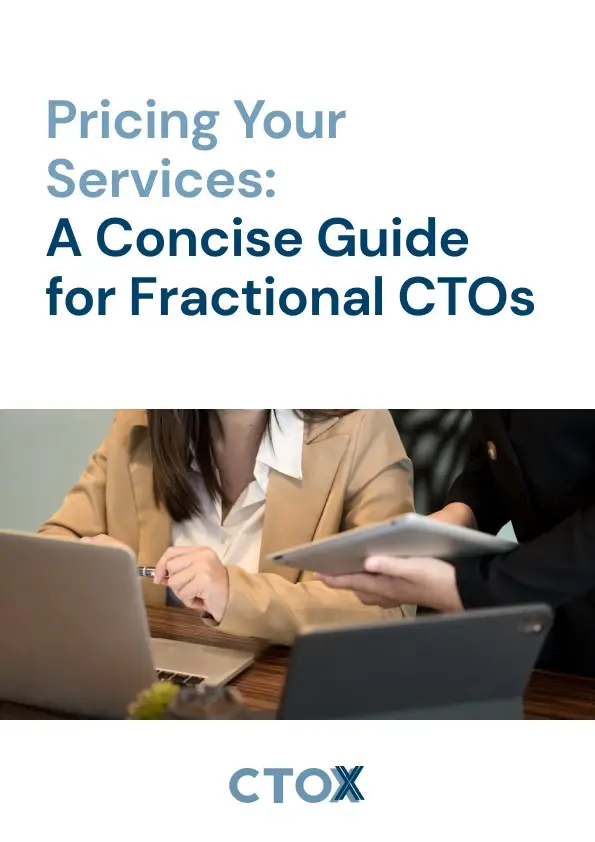Choosing the right tech leadership expertise can transform your business. Whether you’re considering a full-time CTO or a fractional CTO, this guide helps you assess your needs, challenges, and budget.
Key Takeaways:
- When to Hire a CTO: If your business faces unclear tech direction, scaling challenges, or security risks, a CTO can help.
-
CTO Options:
- Full-Time CTO: Ideal for long-term strategy, team management, and daily leadership. Costs $230,000–$380,000/year.
- Fractional CTO: Flexible, part-time option for startups and small businesses. Costs $3,000 to $15,000/Month.
-
Key CTO Responsibilities:
- Strategic tech planning and roadmaps
- Team leadership and skill development
- Security, compliance, and risk management
- Hiring Checklist: Evaluate candidates’ technical skills, leadership abilities, and cultural fit.
Quick Comparison:
| Feature | Full-Time CTO | Fractional CTO |
|---|---|---|
| Cost | $230,000–$380,000/year | $3,000 to $15,000/Month |
| Time Commitment | 40+ hours/week | Value and result-oriented |
| Best For | Scaling teams, long-term goals | SMEs, Startups, short-term projects |
| Integration Speed | Immersed in daily operations | Ready to start immediately |
A CTO can align your tech strategy with business goals, ensuring scalability and innovation. Read on to determine the best fit for your business.
Is a fractional CTO right for your company?
Measure Your Tech Leadership Requirements
The type of tech leadership you need depends on your company’s size, growth stage, and specific challenges. By conducting a focused assessment, you can determine the CTO model that fits your business best. Use the following steps to identify and define your leadership needs.
Consider Your Business Size and Stage
Startups often face challenges with product development. In such cases, hiring a Fractional CTO (typically $3,000 to $15,000/month) provides expert guidance without the expense of a full-time hire. As your company grows and begins tackling scaling or team-building hurdles, transitioning to a part-time or full-time CTO might be more appropriate. Larger organizations dealing with complex technical challenges often benefit from a full-time CTO supported by a skilled tech leadership team.
Identify Your Tech Challenges
Tech problems can lead to significant inefficiencies, costing up to 100 lost hours each year.
"The CIO is playing catch-up. Internal education, including self-education, is imperative." – Diane Carco, President and CEO, Swingtide
Focus on these key areas:
-
Infrastructure Stability
Track downtime, performance issues, and scalability limitations to pinpoint areas that need improvement. -
Security and Compliance
With 57% of CEOs planning to incorporate new technologies into their business models, addressing security vulnerabilities and compliance issues is critical. -
Technical Debt
Outdated systems, manual processes, and backlogs in maintenance can slow innovation and need to be addressed.
Documenting these issues will help you better understand where your team may need additional support.
Assess Your Team’s Skills
Once you’ve outlined your tech challenges, evaluate your team’s strengths and weaknesses to uncover gaps in leadership, technical expertise, and innovation.
Pay attention to areas like:
- Strategic Planning: Are technology initiatives misaligned with business goals? Is there a lack of clear roadmaps?
- Technical Architecture: Frequent outages or delayed launches could signal scalability issues.
- Team Management: High turnover or low productivity might indicate leadership challenges.
- Innovation Leadership: Is your team slow to adopt new technologies or hesitant to explore emerging trends?
To close these gaps, consider performance reviews, mentorship programs, targeted training, or leveraging AI tools to track and improve skills effectively.
Compare Full-Time and Fractional CTOs
Deciding between a full-time CTO and a fractional CTO can influence both your business outcomes and budget. Here’s a breakdown of the key differences.
Work Scope and Time Commitment
The key difference between a full-time CTO and a fractional CTO isn’t about capabilities or impact – it’s about cost structure and time allocation.
A full-time CTO manages your technology organization and provides technical leadership as an employee. They’re embedded in your company culture, attend all executive meetings, and handle both strategic and tactical aspects of your technology operations.
A fractional CTO delivers the same level of technical leadership, but at a fraction of the cost, depending on your needs, focusing on high-leverage activities like strategic planning, team development, and technology road-mapping. They’re ideal for companies that need experienced technology leadership without the overhead of a full-time executive.
The difference isn’t about what gets done, but how efficiently it gets done. A good fractional CTO creates systems and processes that allow them to drive 100% of the impact with 25% of the time commitment.
When to Choose a Full-Time CTO:
- You need daily, hands-on technical leadership.
- Your business requires extensive team building and management.
- Long-term, complex strategic initiatives are a priority.
- Deep alignment with company culture is essential.
Cost Breakdown
The financial implications of hiring a CTO can vary widely. Here’s a comparison of typical costs in the U.S.:
| Component | Full-Time CTO | Fractional CTO |
|---|---|---|
| Base Compensation | $230,000 – $380,000/year | $200 – $500/hour |
| Benefits & Bonuses | Additional 20–30% of salary | None |
| Total Annual Cost | Can exceed $337,500 | $60,000 – $180,000 (varies by engagement) |
Opting for a fractional CTO can reduce costs by up to 70% compared to hiring a full-time executive. Plus, fractional CTOs often bring experience from multiple industries, offering fresh perspectives and creative solutions.
Scaling Options
Both full-time and fractional CTOs provide different advantages when it comes to scaling.
Fractional CTO Benefits:
- Flexible hours based on project needs.
- Adaptable involvement as priorities shift.
- Ability to pivot focus without new hiring.
- Insights from working across various industries.
Full-Time CTO Benefits:
- Build and expand internal tech teams.
- Craft and execute long-term tech strategies.
- Develop sustainable technical workflows.
- Establish a culture of innovation within the company.
"A fractional CTO can provide that trusted advice and guidance you require at a fraction of the cost, freeing up budget for individual contributors who will execute efficiently and effectively under their leadership." – Voltagecontrol.com
With global digital transformation spending expected to hit $3.9 trillion by 2027, choosing the right CTO model is crucial. The right choice ensures your technology investments are managed effectively while keeping the flexibility needed for growth.
This comparison sets the foundation for evaluating candidates’ skills and suitability in the next section.
sbb-itb-4abdf47
CTO Task Checklist
Successful CTOs juggle technical planning, team leadership, and risk management to align technology with business goals. Here’s a closer look at the key responsibilities every CTO should focus on.
Tech Planning and Roadmap
A technology roadmap acts as the strategic guide for your organization.
"As a CTO I am responsible for making sure that we have the right technology roadmap in place for our infrastructure, which enables us to build the best products for our users in the years ahead"
Key planning responsibilities include:
| Planning Area | Core Activities | Expected Outcomes |
|---|---|---|
| Strategic Alignment | Work with C-suite to align with business goals | Clear priorities that drive company objectives |
| Infrastructure Assessment | Review current systems and pinpoint gaps | A detailed inventory of the tech stack |
| Resource Planning | Manage budgets and vendor relationships | Better spending and stronger partnerships |
| Timeline Development | Develop phased implementation plans | Realistic schedules with measurable milestones |
Once the roadmap is ready, the focus shifts to leading the team that will execute these plans.
Tech Team Management
Bringing the roadmap to life requires strong team management. This involves setting clear goals while encouraging innovation.
"There are many boot camps for developers, but who is training the people who will manage these developers to enable the team to grow seamlessly and organically?"
Key practices for managing tech teams include:
- Skills Development: Offer training programs and certifications.
- Team Structure: Define roles and responsibilities as the team expands.
- Communication Framework: Set guidelines for updates and collaboration.
- Performance Metrics: Measure productivity and project success.
- Culture Building: Encourage innovation while maintaining work-life balance.
Risk and Security Management
A CTO must prioritize security and compliance to protect the organization from potential threats.
| Security Focus | Implementation Steps | Risk Mitigation |
|---|---|---|
| Data Protection | Use multi-factor authentication and encryption | Prevent unauthorized access |
| Compliance | Conduct audits and update policies regularly | Stay aligned with regulatory standards |
| Disaster Recovery | Implement backups and incident response plans | Ensure business continuity |
| Employee Training | Run security awareness programs | Minimize risks from human error |
For instance, in March 2023, Spotify‘s Email Verification API reduced email bounce rates from 12.3% to 2.1% in just 60 days, improved deliverability by 34%, and generated $2.3 million in additional revenue.
How to Screen CTO Candidates
Screening CTO candidates effectively means evaluating both their technical expertise and leadership capabilities. Let’s break it down.
Tech Skills and Background
Look for candidates with a solid technical foundation and an understanding of the latest trends in your industry.
"A CTO must have a strong background and understanding of current and emerging technology trends for their specific industry." – Ash Athawale, Managing Director, Robert Half’s executive search practice
| Technical Area | Key Skills | How to Evaluate |
| Architecture | System design, scalability | Discuss past projects and technical plans |
| Security | Risk assessment, compliance | Analyze responses to cybersecurity scenarios |
| Innovation | Awareness of new tech | Ask about emerging trends and applications |
| Development | Coding principles, best practices | Review experience with code and processes |
While technical skills are critical, a strong CTO also needs to lead effectively.
Management Skills
"Abandon outdated, unsupportive management styles in favor of mentorship and accountability." – Alvaro Moya
Assess their ability to:
- Build and mentor technical teams
- Oversee complex projects
- Communicate ideas clearly
- Allocate resources efficiently
These skills ensure they can manage people and processes effectively, not just technology.
Company Fit
Cultural alignment is just as important as technical and managerial skills. Ensure the candidate’s values and vision match your company’s.
| Assessment Area | What to Look For |
|---|---|
| Leadership Style | A collaborative, team-focused approach |
| Vision Alignment | Clear understanding of company goals |
| Communication | Ability to explain complex ideas simply |
| Flexibility | Experience managing organizational change |
Be cautious of warning signs like micromanagement, an overly narrow technical focus, or resistance to adopting new methods.
"Strategic thinking is essential for a CTO to align technology initiatives with the overall business strategy." – Vahid Kowsari, CTO and co-founder of IX Layer
Use behavioral interviews to dig into their past decisions and problem-solving methods. Create scenarios that reflect your company’s challenges to see how they approach solutions.
This framework complements your tech leadership checklist, helping you find the right fit for your organization.
CTO Hiring and Onboarding Plan
When shaping your tech leadership strategy, having a structured CTO hiring and onboarding plan is key to addressing gaps and setting up for success.
First 90 Days Plan
"To overcome these barriers and succeed in joining a new company, you should focus on four pillars of effective onboarding: business orientation, stakeholder connection, alignment of expectations, and cultural adaptation."
| Phase | Timeline | Key Focus Areas | Priority Actions |
| Learning | Days 1-30 | Technology assessment, team dynamics | Research tech stack, meet key stakeholders |
| Planning | Days 31-60 | Strategy development | Create a roadmap, identify quick wins |
| Execution | Days 61-90 | Implementation | Launch initial projects, set up communication channels |
These early steps lay the groundwork for defining major milestones over the next 12 months.
12-Month Objectives
"As a CTO you have to be commercially aware of the economics you’re in… We need to really focus on value: what value can you deliver to your customers, to your organisation, to both drive the value ‘up’ of the product and organisation?" – Mark Joyce
Key goals for the first year should include:
- Technical Infrastructure Review: Assess systems for security, scalability, and efficiency upgrades.
- Team Development: Strengthen the technical team through strategic hiring and skill-building initiatives.
- Innovation Pipeline: Set up processes to evaluate and adopt new technologies that boost customer satisfaction and profitability.
With these objectives in place, focus on seamlessly integrating your CTO into the team.
Team Integration Steps
| Integration Area | Action Items | Expected Outcomes |
|---|---|---|
| Communication | Schedule regular meetings, set up feedback channels | Clear and effective information flow |
| Collaboration | Organize cross-functional workshops, define team protocols | Better team collaboration and alignment |
| Culture Building | Establish shared goals, celebrate achievements | Stronger team identity |
| Stakeholder Engagement | Map key relationships, hold regular check-ins | Clear expectations and alignment |
Consistently gather feedback to fine-tune the integration process. Even small actions – like scheduling meetings that accommodate different time zones – can make a big difference in fostering team cohesion.
Conclusion: Making Your CTO Choice
Key Decision Points
Choosing the right CTO is a critical move, especially with digital transformation spending projected to hit $3.9 trillion by 2027. Here’s a breakdown to help you weigh your options:
| Decision Factor | Full-Time CTO | Fractional CTO |
|---|---|---|
| Budget Impact | $150,000+ annual salary plus benefits | $3,000 to $15,000+ monthly retainer |
| Time Investment | 40+ hours/week dedicated presence | Flexible hours based on needs |
| Strategic Focus | Full integration into your company | Focused on specific projects |
| Speed of Integration | Fully immersed in culture and operations | Ready to start immediately |
"For startups and smaller companies that need high-level technical leadership without a full-time budget, fractional is an amazing value." – Ken Mocabee
These factors can help you pinpoint the best option for your business and move forward with confidence.
Next Steps
Follow these steps to finalize your CTO decision:
Define Your Technology Vision
Work closely with your team and stakeholders to outline your company’s technical goals.
"There’s no good business strategy without an IT strategy supporting it, and there’s no good IT strategy that isn’t aligned to business strategy."
Set Clear Expectations
Spell out deliverables, communication methods, and availability requirements to avoid misunderstandings.
Plan Integration Timeline
Develop a detailed onboarding process, including:
- Assessing current technology and team dynamics
- Crafting a strategic plan and roadmap
- Launching initial projects
- Regularly reviewing progress and making adjustments
Whether you go with a full-time or fractional CTO, ensure the environment fosters their success.







